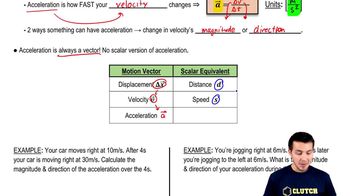Here are the essential concepts you must grasp in order to answer the question correctly.
Power and Work
Power is the rate at which work is done or energy is transferred. In the context of vehicles, engine power is crucial for understanding how quickly a car can accelerate. The relationship between power, force, and velocity is given by the equation P = F * v, where P is power, F is force, and v is velocity. This concept helps in determining how much of the engine's power contributes to the car's acceleration.
Recommended video:
Acceleration
Acceleration is the rate of change of velocity of an object. In this scenario, the maximum acceleration (aₘₐₓ) can be calculated using Newton's second law, F = m * a, where F is the net force acting on the car, m is its mass, and a is acceleration. Understanding how acceleration relates to the forces acting on the car, including friction and engine power, is essential for determining the car's speed at maximum power output.
Recommended video:
Weight Distribution
Weight distribution refers to how the weight of a vehicle is spread across its wheels. In this case, two-thirds of the car's weight is over the drive wheels, which affects traction and the ability to accelerate. The normal force on the drive wheels influences the frictional force available for acceleration, making it a critical factor in calculating the maximum speed the car can achieve when reaching maximum power output.
Recommended video:
 Verified step by step guidance
Verified step by step guidance


